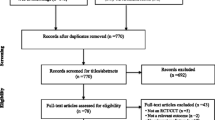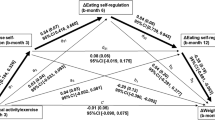Abstract
Behavior change interventions are effective to the extent that they affect appropriately-measured outcomes, especially in experimental controlled trials. The primary goal of this study was to analyze the impact of a 1-year weight management intervention based on self-determination theory (SDT) on theory-based psychosocial mediators, physical activity/exercise, and body weight and composition. Participants were 239 women (37.6 ± 7.1 years; 31.5 ± 4.1 kg/m2) who received either an intervention focused on promoting autonomous forms of exercise regulation and intrinsic motivation, or a general health education program (controls). At 12 months, the intervention group showed increased weight loss (−7.29%,) and higher levels of physical activity/exercise (+138 ± 26 min/day of moderate plus vigorous exercise; +2,049 ± 571 steps/day), compared to controls (P < 0.001). Main intervention targets such as more autonomous self-regulation (for treatment and for exercise) and a more autonomous perceived treatment climate revealed large effect sizes (between 0.80 and .96), favoring intervention (P < 0.001). Results suggest that interventions grounded in SDT can be successfully implemented in the context of weight management, enhancing the internalization of more autonomous forms of behavioral regulation, and facilitating exercise adherence, while producing clinically-significant weight reduction, when compared to a control condition. Findings are fully consistent with previous studies conducted within this theoretical framework in other areas of health behavior change.




Similar content being viewed by others
References
Blair, S. N., Haskell, W. L., Ho, P., Paffenbarger, R. S., Jr., Vranizan, K. M., Farquhar, J. W., et al. (1985). Assessment of habitual physical activity by a 7-day recall in a community survey and controlled experiments. American Journal of Epidemiology, 122(5), 794–804.
Catenacci, V. A., & Wyatt, H. R. (2007). The role of physical activity in producing and maintaining weight loss. Nature Clinical Practice Endocrinology & Metabolism, 3(7), 518–529.
Chatzisarantis, N., & Hagger, M. (2009). Effects of an intervention based on self-determination theory on self-reported leisure-time physical activity participation. Psychology and Health, 24(1), 29–48.
Cohen, J. (1988). Statistical power analysis for the behavioral sciences. Hillsdale: Lawrence Earlbaum Associates.
Cooper, Z., & Fairburn, C. G. (2001). A new cognitive behavioural approach to the treatment of obesity. Behaviour Research and Therapy, 39(5), 499–511.
Deci, E. L., Eghrari, H., Patrick, B. C., & Leone, D. R. (1994). Facilitating internalization: the self-determination theory perspective. Journal of Personality, 62(1), 119–142.
Deci, E., & Ryan, R. (1985). Intrinsic motivation and self-determination in human behavior. New York: Plenum.
Deci, E., & Ryan, R. (2008). Self-determination theory: A macrotheory of human motivation, development, and health. Canadian Psychology, 49(3), 182–185.
Donnelly, J. E., Blair, S. N., Jakicic, J. M., Manore, M. M., Rankin, J. W., & Smith, B. K. (2009). American college of sports medicine position stand. Appropriate physical activity intervention strategies for weight loss and prevention of weight regain for adults. Medicine and Science in Sports and Exercise, 41(2), 459–471.
Donnelly, J. E., Smith, B., Jacobsen, D. J., Kirk, E., Dubose, K., Hyder, M., et al. (2004). The role of exercise for weight loss and maintenance. Best Practice & Research Clinical Gastroenterology, 18(6), 1009–1029.
Edmunds, J., Ntoumanis, N., & Duda, J. (2008). Testing a selfdetermination theory-based teaching style intervention in the exercise Domain. European Journal of Social Psychology, 38, 375–388.
Fortier, M. S., Sweet, S. N., O’Sullivan, T. L., & Williams, G. (2007). A self-determination process model of physical activity adoption in the context of a randomized controlled trial. Psychology of Sport and Exercise, 8, 741–757.
Hayden-Wade, H. A., Coleman, K. J., Sallis, J. F., & Armstrong, C. (2003). Validation of the telephone and in-person interview versions of the 7-day PAR. Medicine and Science in Sports and Exercise, 35(5), 801–809.
Jakicic, J. M., Marcus, B. H., Gallagher, K. I., Napolitano, M., & Lang, W. (2003). Effect of exercise duration and intensity on weight loss in overweight, sedentary women: A randomized trial. Jama, 290(10), 1323–1330.
Le Masurier, G. C., & Tudor-Locke, C. (2003). Comparison of pedometer and accelerometer accuracy under controlled conditions. Medicine and Science in Sports and Exercise, 35(5), 867–871.
Markland, D. (1999). Self-Determination moderates the effects of perceived competence on intrinsic motivation in an exercise setting. Journal of Sport and Exercise Psychology, 21, 351–361.
Markland, D., & Hardy, L. (1997). On the factorial and construct validity of the intrinsic motivation inventory: conceptual and operational concerns. Research Quarterly for Exercise and Sport, 68(1), 20–32.
Markland, D., & Ingledew, D. (1997). The measurement of exercise motives: factorial validity and Invariance across gender of a revised exercise motivation inventory. British Journal of Health Psychology, 2, 361–376.
Martinez-Gonzalez, M. A., Varo, J. J., Santos, J. L., De Irala, J., Gibney, M., Kearney, J., et al. (2001). Prevalence of physical activity during leisure time in the European Union. Medicine and Science in Sports and Exercise, 33(7), 1142–1146.
Mata, J., Silva, M. N., Vieira, P. N., Carraca, E. V., Andrade, A. M., Coutinho, S. R., et al. (2009). Motivational “spill-over” during weight control: Increased self-determination and exercise intrinsic motivation predict eating self-regulation. Health Psychology, 28(6), 709–716.
Mcauley, E., Duncan, T., & Tammen, V. V. (1989). Psychometric properties of the intrinsic motivation inventory in a competitive sport setting: a confirmatory factor analysis. Research Quarterly for Exercise and Sport, 60(1), 48–58.
Mcbride, P. E., Einerson, J. A., Grant, H., Sargent, C., Underbakke, G., Vitcenda, M., et al. (2008). Putting the diabetes prevention program into practice: A program for weight loss and cardiovascular risk reduction for patients with metabolic syndrome or type 2 diabetes mellitus. The Journal Of Nutrition, Health & Aging, 12(10), 745s–749s.
Michie, S., & Abraham, C. (2004). Interventions to change health behaviours: evidence-based or evidence-inspired? Psychology and Health, 19, 29–49.
Rose, E., Parfitt, G., & Williams, G. (2005). Exercise causality orientations, behavioral regulation for exercise and stage of change for exercise: Exploring their relationships. Psychology Sport Exercise, 6, 399–414.
Rutten, A., & Abu-Omar, K. (2004). Prevalence of physical activity in the European Union. Preventive Medicine, 49(4), 281–289.
Ryan, R., & Connell, J. (1989). Perceived locus of causality and internalization: Examining reasons for acting in two domains. Journal of Personality and Social Psychology, 57, 749–761.
Ryan, R. M., & Deci, E. L. (2000). Self-determination theory and the facilitation of intrinsic motivation, social development, and well-being. American Psychologist, 55(1), 68–78.
Ryan, R., Frederick, C., Lepes, D., Rubio, N., & Sheldon, K. (1997). Intrinsic motivation and exercise adherence. International Journal of Psychology, 28, 335–354.
Saris, W. H., Blair, S. N., Van Baak, M. A., Eaton, S. B., Davies, P. S., Di Pietro, L., et al. (2003). How much physical activity is enough to prevent unhealthy weight gain? Outcome of the IASO 1st stock conference and consensus statement. Obesity Reviews, 4(2), 101–114.
Sharma, M. (2007). Behavioural interventions for preventing and treating obesity in adults. Obesity Reviews, 8(5), 441–449.
Shaw, K., Gennat, H., O’rourke, P. & Del Mar, C. (2006). Exercise for overweight or obesity. Cochrane Database Syst Rev(4):CD003817.
Sheldon, K., Ryan, R., & Reis, H. (1996). What makes for a good day? Personality and Social Psychology Bulletin, 22, 1270–1279.
Sheldon, G., Williams, G., & Joiner, T. (2003). Self-determination theory in the clinic: Motivating physical and mental health. New Haven: Yale University Press.
Silva, M. N., Markland, D. A., Minderico, C. S., Vieira, P. N., Castro, M. M., Coutinho, S. R., et al. (2008). A randomized controlled trial to evaluate self-determination theory for exercise adherence and weight control: Rationale and intervention description. BMC Public Health, 8(1), 234.
Spiegel, A. M., & Alving, B. M. (2005). Executive summary of the strategic plan for national institutes of health obesity research. American Journal of Clinical Nutrition, 82(1 Suppl), 211S–214S.
Teixeira, P. J., Going, S. B., Houtkooper, L. B., Cussler, E. C., Metcalfe, L. L., Blew, R. M., et al. (2006). Exercise motivation, eating, and body image variables as predictors of weight control. Medicine and Science in Sports and Exercise, 38(1), 179–188.
Teixeira, P. J., Silva, M. N., Coutinho, S. R., Palmeira, A. L., Mata, J., Vieira, P. N., et al. (2009). Mediators of weight loss and weight loss maintenance in middle-aged women. Obesity (Silver Spring) Aug 20 [Epub ahead of print].
Thogersen-Ntoumani, C., & Ntoumanis, N. (2006). The role of self-determined motivation in the understanding of exercise-related behaviours, cognitions and physical self-evaluations. Journal of Sports Sciences, 24(4), 393–404.
Tudor-Locke, C., & Bassett, D. R., Jr. (2004). How many steps/day are enough? Preliminary pedometer indices for public health. Sports Medicine, 34(1), 1–8.
Tuomilehto, J., Lindstrom, J., Eriksson, J. G., Valle, T. T., Hamalainen, H., Ilanne-Parikka, P., et al. (2001). Prevention of type 2 diabetes mellitus by changes in lifestyle among subjects with impaired glucose tolerance. New England Journal of Medicine, 344(18), 1343–1350.
Varo, J. J., Martinez-Gonzalez, M. A., De Irala-Estevez, J., Kearney, J., Gibney, M., & Martinez, J. A. (2003). Distribution and determinants of sedentary lifestyles in the European Union. International Journal of Epidemiology, 32(1), 138–146.
Ware, J. H. (2003). Interpreting incomplete data in studies of diet and weight loss. New England Journal of Medicine, 348(21), 2136–2137.
Washburn, R. A., Jacobsen, D. J., Sonko, B. J., Hill, J. O., & Donnelly, J. E. (2003). The validity of the Stanford 7-day physical activity recall in young adults. Medicine and Science in Sports and Exercise, 35(8), 1374–1380.
Welk, G. J., Differding, J. A., Thompson, R. W., Blair, S. N., Dziura, J., & Hart, P. (2000). The utility of the Digi-walker step counter to assess daily physical activity patterns. Medicine and Science in Sports and Exercise, 32(9 Suppl), S481–S488.
Williams, G. C., Freedman, Z. R., & Deci, E. L. (1998). Supporting autonomy to motivate patients with diabetes for glucose control. Diabetes Care, 21(10), 1644–1651.
Williams, G. C., Gagne, M., Ryan, R. M., & Deci, E. L. (2002a). Facilitating autonomous motivation for smoking cessation. Health Psychology, 21(1), 40–50.
Williams, G. C., Grow, V. M., Freedman, Z. R., Ryan, R. M., & Deci, E. L. (1996). Motivational predictors of weight loss and weight-loss maintenance. Journal of Personality and Social Psychology, 70(1), 115–126.
Williams, G. C., Mcgregor, H. A., Sharp, D., Levesque, C., Kouides, R. W., Ryan, R. M., et al. (2006). Testing a self-determination theory intervention for motivating tobacco cessation: Supporting autonomy and competence in a clinical trial. Health Psychology, 25(1), 91–101.
Williams, G. C., Mcgregor, H. A., Zeldman, A., Freedman, Z. R., & Deci, E. L. (2004). Testing a self-determination theory process model for promoting glycemic control through diabetes self-management. Health Psychology, 23(1), 58–66.
Williams, G. C., Minicucci, D. S., Kouides, R. W., Levesque, C. S., Chirkov, V. I., Ryan, R. M., et al. (2002b). Self-determination, smoking, diet and health. Health Education Research, 17(5), 512–521.
Wilson, D. K., Evans, A. E., Williams, J., Mixon, G., Sirard, J. R., & Pate, R. (2005). A preliminary test of a student-centered intervention on increasing physical activity in underserved adolescents. Annals of Behavioral Medicine, 30(2), 119–124.
Wilson, P., & Rodgers, W. (2003). The relationship between perceived autonomy support exercise regulations and behavioural intentions in women. Psychology of Sport and Exercise, 5, 229–242.
Wilson, P. M., Rodgers, W. M., Fraser, S. N., & Murray, T. C. (2004). Relationships between exercise regulations and motivational consequences in university students. Research Quarterly for Exercise and Sport, 75(1), 81–91.
Wing, R., & Hill, J. (2001). Successful weight loss maintenance. Annual Review Nutrition, 21, 323–341.
Acknowledgments
This study was funded by grants by the Portuguese Science and Technology Foundation (FCT-POCI/DES/57705/2004 and SFRH/BD/21372/2005 to Marlene N. Silva) and the Calouste Gulbenkian Foundation (grant number 65565/2004). The investigators are also grateful to the Oeiras City Council, Nestlé Portugal, and IBESA for their additional financial support.
Author information
Authors and Affiliations
Corresponding author
Additional information
Clinical Trials.gov number NCT0051308.
Rights and permissions
About this article
Cite this article
Silva, M.N., Vieira, P.N., Coutinho, S.R. et al. Using self-determination theory to promote physical activity and weight control: a randomized controlled trial in women. J Behav Med 33, 110–122 (2010). https://doi.org/10.1007/s10865-009-9239-y
Received:
Accepted:
Published:
Issue Date:
DOI: https://doi.org/10.1007/s10865-009-9239-y




